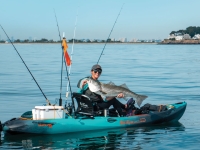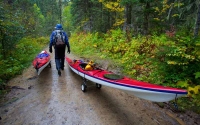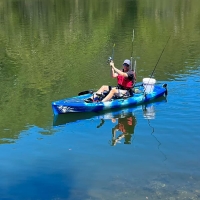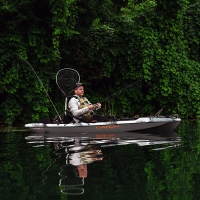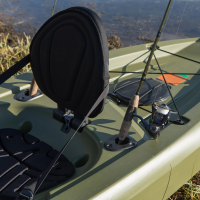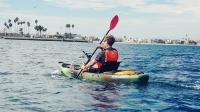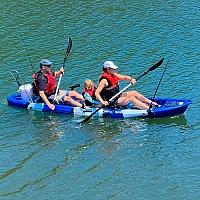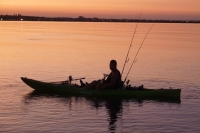Understanding the Basics of Kayak Fishing
If you've been bitten by the fishing bug and are interested in taking your passion to new waterways, you're in the right place. Kayak fishing is an exhilarating, yet calming experience. It's a blend of serenity and excitement, allowing you to experience fishing in an entirely new light, literally closer to the water. It brings a mix of sports, adventure, and relaxation and requires a unique set of skills, which you’ll steadily master over time.
While kayak fishing, you have the freedom to explore secluded fishing spots, far from crowded shores. It's an eco-friendly activity that allows you to quietly sneak up on fish without disturbing their natural habitat. This element of stealth can dramatically increase your chances of landing a catch. However, it's important to remember that while a kayak can get you to fantastic fishing spots, it's not just about the destination, it's also about the journey. And that journey becomes rewarding when you are comfortable with the basics of kayak fishing.
When you first start kayak fishing, you may encounter some challenges, but these obstacles will become easier to overcome with experience. Practice makes perfect, after all. From understanding how to position your kayak, to perfecting your casting and reeling, to knowing the optimal time for fishing, every step counts in defining your success. But before you rush to those glittering waters, let's guide you through the essentials of selecting the right fishing kayak.
Choosing the Right Fishing Kayak: Factors to Consider
Kayaks for fishing aren't a one-size-fits-all purchase. When choosing a fishing kayak, you need to consider several factors, each playing a critical role in your fishing experience. There are two primary types of kayaks – sit-on-top and sit-in kayaks. Sit-on-top kayaks are generally more popular among anglers due to their stability and storage space, while sit-in kayaks are great for speed and maneuverability.
Another critical factor to consider is the kayak's size. If you plan on fishing in calm water bodies like lakes or slow-moving rivers, a wider kayak can provide more stability. On the contrary, for faster moving waters or when covering large distances, a sleek, longer kayak would be more suitable. It's also essential to pay attention to the kayak's weight capacity. You need to ensure that it can comfortably support your weight along with the weight of all your fishing gear.
Remember, the right kayak is the one that fits your specific needs and circumstances. When deciding, consider where you plan on fishing, the type of fish you aim to catch, and how you plan to transport your kayak. Just like in fishing, patience is key in choosing the right kayak. With careful consideration, you'll find the perfect companion for your fishing trips.
Essential Kayak Fishing Gear and How to Use Them
Now that we've covered kayak selection let's shift our focus to fishing gear. While the temptation to load up on every piece of fishing equipment can be strong, it's important to prioritize the essentials for a successful, safe, and enjoyable kayak fishing experience.
Your first companion is a good quality paddle. Despite the variety of propulsion systems available today, a paddle remains the primary way to navigate your kayak. Ensure your paddle is lightweight yet strong, and the length is appropriate for your kayak’s width and your height. Secondly, never underestimate the importance of a Personal Flotation Device (PFD). Safety should always be your priority, and a well-fitted PFD is a must-have.
You'll also need a fishing rod and reel suitable for your target species and fishing environment. Along with this, pack a tackle box with an assortment of hooks, lines, and baits. A kayak crate is also handy for storage. Keep in mind, as kayak space is limited, efficient organization of your gear is essential. Consider investing in gear tracks and mounts for convenient access to equipment without compromising your kayak's stability.
With a basic understanding of kayak fishing, the right equipment, and essential fishing gear, you're ready to cast your line. But how do you master the art of casting from a kayak? We'll delve into that next.
Casting and Reeling Techniques Specific to Kayak Anglers
Learning how to cast and reel effectively while balancing on a kayak is like learning to dance to a new rhythm. It's a game of precision, patience, and balance. You're not just fishing, you're combining fishing with the art of kayaking, making it a unique experience.
The first technique to master is one-handed casting. Given that you may need to have one hand on your paddle at all times, one-handed casting becomes a necessary skill. Practice this technique with both baitcasting and spinning reels. Also, perfect the art of underhand casting. This technique provides you with the ability to cast under overhanging trees and docks, and is also safer in a kayak given the limited space.
A good reeling technique goes hand-in-hand with casting. When you feel a bite, it's important to set the hook firmly. Then, maintain tension on the line while reeling in, but remember not to keep it too tight. Fighting a fish from a kayak is a delicate balance. You'll need to carefully manage the fish, steering your kayak with your body and paddle, while keeping the line tension. It might sound like a tricky dance at first, but with practice, it will become a natural rhythm.
How to Use Electronic Fish Finders for Kayak Fishing
Fish finders can be your best friend on a fishing kayak. They are compact devices that use sonar to detect the presence and location of fish underwater. This tool helps you see what's happening beneath the surface, giving you the ability to find the best fishing spots.
To use a fish finder, first install it on your kayak. The transducer, which sends and receives the sonar signals, should be mounted below the waterline. The display screen should be mounted where you can easily see it. Once installed, you can set it to your preferred settings. Start with automatic mode, and as you learn more about interpreting the readings, you can experiment with different settings.
Reading a fish finder screen can be a bit confusing initially. You'll see lines, colors, and symbols, all of which represent something. The most important thing is distinguishing between the bottom, which is usually shown as a thick line, and fish, which are typically shown as arches or dots. With time and experience, you'll be able to read these screens like an underwater map, pinpointing the prime fishing spots.
Effective Techniques for Kayak Navigation and Positioning in Various Water Conditions
Whether you are on a calm lake, a flowing river, or a wavy sea, each water condition requires specific navigation and positioning techniques. In calm waters, you can paddle easily and position your kayak accurately over fishing spots. In such conditions, a lightweight paddle and a well-placed cast are your best strategies.
On flowing rivers, current and direction become significant factors. To keep your kayak stationary in a moving river, you'll need to learn how to "ferry" — a technique that uses the water's flow to keep you in place. It requires some practice but is incredibly effective.
When in wavy or windy conditions, maintaining your position and balance becomes more challenging. A useful technique here is to use a drift chute or an anchor to keep you in place. Remember, safety is paramount in such conditions, so if the waves get too high or the wind too strong, it might be best to head back to shore.
Effective Techniques for Kayak Navigation and Positioning in Various Water Conditions
Whether you are on a calm lake, a flowing river, or a wavy sea, each water condition requires specific navigation and positioning techniques. In calm waters, you can paddle easily and position your kayak accurately over fishing spots. In such conditions, a lightweight paddle and a well-placed cast are your best strategies.
On flowing rivers, current and direction become significant factors. To keep your kayak stationary in a moving river, you'll need to learn how to "ferry" — a technique that uses the water's flow to keep you in place. It requires some practice but is incredibly effective.
When in wavy or windy conditions, maintaining your position and balance becomes more challenging. A useful technique here is to use a drift chute or an anchor to keep you in place. Remember, safety is paramount in such conditions, so if the waves get too high or the wind too strong, it might be best to head back to shore.
Safety Measures and Practices for Kayak Fishing
While kayak fishing can be a tranquil, solitary activity, it's essential to keep safety at the forefront of your mind. Always wear a PFD, regardless of your swimming abilities. In an emergency, it can make the difference between life and death.
Weather conditions can change rapidly, so it's wise to check the weather forecast before heading out. If you see darkening skies, increasing winds, or sudden temperature drops, it's best to return to shore. Lightning, in particular, is a significant risk to those on the water.
Finally, always let someone know your fishing plan. Inform them of your intended location, planned departure and return times, and the route you're taking. In case of an unexpected situation, having someone aware of your whereabouts can be crucial.
Fishing Rod and Line Selection for Kayak Angling
Your fishing rod and line play a significant role in your kayak fishing experience. It's essential to select the right ones based on the type of fish you're targeting and the fishing environment.
For most kayak anglers, a medium power rod with a fast action is a versatile choice. The length should be between 6.5 to 7.5 feet for ease of maneuverability. The type of rod – spinning or casting – would depend on your preference and the type of fishing you plan on doing.
The line selection depends on the species you're targeting and the cover you'll be fishing around. Monofilament is a good all-around choice, while fluorocarbon is excellent when you need a little more sensitivity and less visibility underwater. Braided line is very strong and excellent for fishing around heavy cover.
Catch and Release Practices for the Responsible Kayak Angler
If you're not fishing for a meal, catch and release is the way to go. It helps preserve fish populations, ensuring there are plenty of fish for the future. But it's not just about letting the fish go, it's about how you handle them.
When you catch a fish, wet your hands before touching it. This preserves their slime coat, which protects them from infections. Avoid keeping the fish out of water for more than a few seconds. If you're taking a photo, do it quickly and then gently place the fish back in the water.
When removing the hook, use a pair of needle-nose pliers and be as gentle as possible. If the fish is deeply hooked, it might be better to cut the line close to the mouth rather than attempting to remove the hook.
Kayak Fishing Frequently Asked Questions
Q: What is the best kayak for fishing?
A: The best kayak for fishing depends on several factors, including the type of water you'll be fishing in, the kind of fish you're targeting, and personal comfort. A sit-on-top kayak is usually preferred for fishing due to its stability and storage space. Check out some Buying Guides HERE
Q: What essential gear do I need for kayak fishing?
A: Essential kayak fishing gear includes a good quality paddle, a personal flotation device (PFD), fishing rod and reel, tackle box with an assortment of hooks, lines, and baits, and a kayak crate for storage. You might also consider a fish finder, anchor, or drift chute.
Q: How do I maintain balance while fishing from a kayak?
A: Maintaining balance while fishing from a kayak involves a mix of proper body positioning, weight distribution, and practice. Start by ensuring your weight is evenly distributed. Keep your head at the centerline of the kayak, and use your hips to control the kayak's tilt and direction.
Q: How do I use a fish finder in a kayak?
A: A fish finder is installed on your kayak with the transducer mounted below the waterline and the display screen where you can easily see it. It sends out sonar signals that bounce off objects underwater and return to the device, providing an image of what's below.
Q: What are the best casting and reeling techniques for kayak fishing?
A: One-handed casting and underhand casting are essential techniques for kayak fishing. For reeling, it's crucial to maintain the right tension on the line, not too loose that the fish escapes, and not too tight that the line breaks.
Q: How can I stay safe while kayak fishing?
A: Always wear a PFD when kayak fishing, regardless of how good a swimmer you are. Check the weather forecast before heading out, avoid fishing during storms, and always let someone know your fishing plan including the location and expected return time.
Q: How do I choose the right fishing rod and line for kayak angling?
A: The selection of a fishing rod and line depends on the species you're targeting and the environment you're fishing in. A medium power rod with a fast action is usually versatile. The line type can range from monofilament for general use, to fluorocarbon or braided line for specific scenarios.
Q: What are the best practices for catch and release in kayak fishing?
A: Always wet your hands before handling fish to protect their slime coat. Limit the fish's time out of water, and be gentle when removing the hook. If the fish is deeply hooked, it might be better to cut the line close to the mouth instead of trying to remove the hook.
Q: How do weather patterns and seasons influence kayak fishing?
A: Fish tend to be more active during the cooler parts of the day and during changes in barometric pressure, such as just before a storm. Seasons also affect fish behavior. For instance, many species move into shallow areas to spawn in spring and feed in fall.
Q: How can I navigate and position my kayak effectively in various water conditions?
A: The technique varies depending on the water conditions. In calm waters, simple paddling is enough. In flowing rivers, you might need to learn how to "ferry." In wavy or windy conditions, a drift chute or an anchor can help you maintain your position.
Weather Patterns, Seasons, and How They Influence Kayak Fishing
Weather and seasons have a significant influence on fish behavior, which in turn affects your fishing strategy. Understanding these patterns can make you a more successful angler.
In general, fish tend to be more active during cooler parts of the day, such as early morning or late evening. They also become more active when the barometric pressure changes, such as just before a storm. However, fishing during a storm can be dangerous, so always put safety first.
Seasons also affect fish behavior. In spring, many species move into shallow areas to spawn, making this a great time for fishing. Summer can be more challenging as many fish move to deeper, cooler water. In fall, fish often move back into shallow areas to feed, making this another excellent fishing season. Understanding these patterns and adjusting your strategy accordingly can greatly enhance your fishing success.
As we've journeyed through the depths of kayak fishing, we've covered essential techniques, gear, and safety practices. From the nuances of casting and reeling to mastering the use of a fish finder and appreciating the influences of weather and seasons, every aspect adds a layer of complexity and excitement to this sport. And with every challenge overcome, your bond with nature strengthens, making each trip an adventure worth taking.
However, while we have tried to equip you with valuable knowledge and strategies, remember that each fishing trip is a chance to learn something new. It's a chance to become a better angler and a more conscientious steward of our waters. So, with each cast you make, keep your mind open to new experiences, stay respectful of nature, and enjoy the journey. After all, that's what kayak fishing is all about.
Happy fishing!
